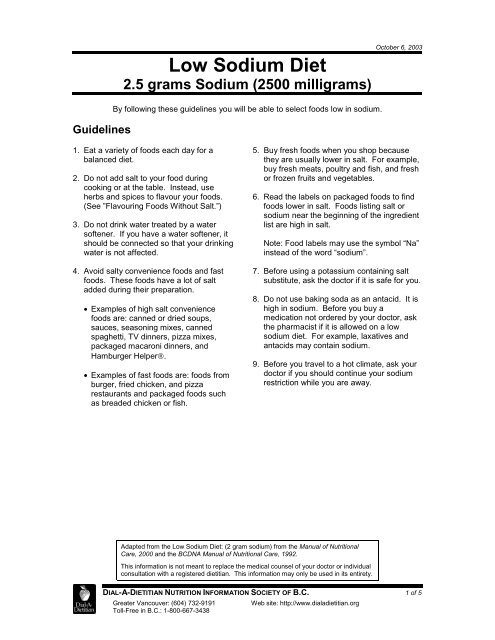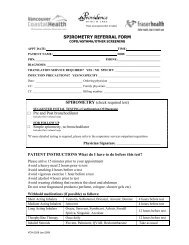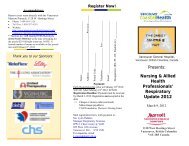Low Sodium Diet: 2.5 grams Sodium (2500 ... - The Lung Centre
Low Sodium Diet: 2.5 grams Sodium (2500 ... - The Lung Centre
Low Sodium Diet: 2.5 grams Sodium (2500 ... - The Lung Centre
Create successful ePaper yourself
Turn your PDF publications into a flip-book with our unique Google optimized e-Paper software.
Guidelines<br />
<strong>Low</strong> <strong>Sodium</strong> <strong>Diet</strong><br />
<strong>2.5</strong> <strong>grams</strong> <strong>Sodium</strong> (<strong>2500</strong> milli<strong>grams</strong>)<br />
By following these guidelines you will be able to select foods low in sodium.<br />
October 6, 2003<br />
1. Eat a variety of foods each day for a<br />
balanced diet.<br />
2. Do not add salt to your food during<br />
cooking or at the table. Instead, use<br />
herbs and spices to flavour your foods.<br />
(See ”Flavouring Foods Without Salt.”)<br />
3. Do not drink water treated by a water<br />
softener. If you have a water softener, it<br />
should be connected so that your drinking<br />
water is not affected.<br />
4. Avoid salty convenience foods and fast<br />
foods. <strong>The</strong>se foods have a lot of salt<br />
added during their preparation.<br />
• Examples of high salt convenience<br />
foods are: canned or dried soups,<br />
sauces, seasoning mixes, canned<br />
spaghetti, TV dinners, pizza mixes,<br />
packaged macaroni dinners, and<br />
Hamburger Helper®.<br />
• Examples of fast foods are: foods from<br />
burger, fried chicken, and pizza<br />
restaurants and packaged foods such<br />
as breaded chicken or fish.<br />
5. Buy fresh foods when you shop because<br />
they are usually lower in salt. For example,<br />
buy fresh meats, poultry and fish, and fresh<br />
or frozen fruits and vegetables.<br />
6. Read the labels on packaged foods to find<br />
foods lower in salt. Foods listing salt or<br />
sodium near the beginning of the ingredient<br />
list are high in salt.<br />
Note: Food labels may use the symbol “Na”<br />
instead of the word “sodium”.<br />
7. Before using a potassium containing salt<br />
substitute, ask the doctor if it is safe for you.<br />
8. Do not use baking soda as an antacid. It is<br />
high in sodium. Before you buy a<br />
medication not ordered by your doctor, ask<br />
the pharmacist if it is allowed on a low<br />
sodium diet. For example, laxatives and<br />
antacids may contain sodium.<br />
9. Before you travel to a hot climate, ask your<br />
doctor if you should continue your sodium<br />
restriction while you are away.<br />
Adapted from the <strong>Low</strong> <strong>Sodium</strong> <strong>Diet</strong>: (2 gram sodium) from the Manual of Nutritional<br />
Care, 2000 and the BCDNA Manual of Nutritional Care, 1992.<br />
This information is not meant to replace the medical counsel of your doctor or individual<br />
consultation with a registered dietitian. This information may only be used in its entirety.<br />
DIAL-A-DIETITIAN NUTRITION INFORMATION SOCIETY OF B.C. 1 of 5<br />
Greater Vancouver: (604) 732-9191<br />
Web site: http://www.dialadietitian.org<br />
Toll-Free in B.C.: 1-800-667-3438
<strong>Low</strong> sodium diet: <strong>2.5</strong> <strong>grams</strong> sodium (cont'd) October 6, 2003<br />
Further Information<br />
Recommended Cookbooks<br />
Important: For foods allowed or not<br />
allowed, follow these guidelines, not the<br />
cookbook. <strong>The</strong>se cookbooks are<br />
recommended for recipes and flavouring<br />
ideas, not as replacements for your diet<br />
guidelines.<br />
Note: For all cookbooks, use only recipes<br />
that contain no more than 500 mg sodium<br />
per serving (see the recipe analysis).<br />
1. Starke, R. D., & Winston, M. (1995). <strong>The</strong><br />
American Heart Association low-salt<br />
cookbook: A complete guide to reducing<br />
sodium and fat. Toronto, ON: Random<br />
House of Canada, Ltd.<br />
2. Lindsay, A. (1998). Anne Lindsay’s new<br />
light cooking. Toronto, ON: Ballantine<br />
Books.<br />
3. Lindsay, A. (1991). Lighthearted everyday<br />
cooking. Toronto, ON: Macmillan of<br />
Canada.<br />
4. Stern, B. (1996). More HeartSmart<br />
cooking. Toronto, ON: Random House.<br />
5. Stern, B. (1994). Simply HeartSmart<br />
cooking. Toronto, ON: Random House.<br />
6. Jamal, K. (1998) HeartSmart Flavours of<br />
India. Vancouver, BC: Douglas and<br />
McIntyre.<br />
7. Wong, S. (1996). HeartSmart Chinese<br />
cooking. Vancouver, BC: Douglas and<br />
McIntyre.<br />
Eating Out on the <strong>Low</strong><br />
<strong>Sodium</strong> <strong>Diet</strong><br />
Choose restaurants that will prepare food<br />
without salt. If you eat out regularly, make it<br />
a habit to select meals lower in salt. Ask the<br />
dietitian/nutritionist which of your favourite<br />
foods are low in sodium.<br />
Sample Menu for Eating Out<br />
Note: Ask for gravy, sauce or dressing on the<br />
side. If it tastes salty, do not eat it or use only<br />
a small amount.<br />
• Appetizer with sauce on the side (for<br />
example, chicken wings with BBQ sauce on<br />
the side)<br />
• Salad with oil and vinegar (or dressing on<br />
the side)<br />
• Broiled, baked, roasted, poached, or grilled<br />
meat, poultry or seafood (with sauce or<br />
gravy on the side)<br />
• Plain vegetables, potato, rice, or rolls<br />
• Dessert<br />
• Milk, fruit juice, soft drinks, coffee or tea<br />
Guide for Restaurant Meals<br />
• Sandwiches: Choose fillings of vegetables,<br />
roasted meat or poultry, egg, hard cheese,<br />
or fish. Avoid fillings of ham, processed<br />
meats, processed cheese and pickles.<br />
• Pasta: All sauces are high in salt. Avoid<br />
high salt ingredients such as ham,<br />
parmesan or romano cheese, or olives.<br />
• Chinese Food: Most foods served in<br />
Chinese restaurants are high in sodium.<br />
Eat Chinese food only occasionally.<br />
Choose plain rice rather than rice or<br />
noodles mixed with sauces. Avoid added<br />
sauces (like soy sauce or teriyaki sauce).<br />
• On hamburgers choose tomato, onion,<br />
lettuce, hard cheese. Do not order<br />
processed cheese. Use condiments (relish,<br />
ketchup, mustard) sparingly.<br />
• Fish and Chips: Ask for unsalted fries. Add<br />
lemon or vinegar, not salt or ketchup. If the<br />
batter tastes salty, eat only a small amount.<br />
• Curries: Ask for foods prepared without salt.<br />
Avoid salty chutneys or relishes.<br />
• Pizzas: All pizzas are high in salt. <strong>The</strong> ones<br />
that are lowest in salt are the vegetarian<br />
pizzas made with real mozzarella cheese<br />
and fresh vegetables (no olives), no<br />
processed meats. Try pizza without tomato<br />
sauce for an even lower sodium treat.<br />
Adapted from the <strong>Low</strong> <strong>Sodium</strong> <strong>Diet</strong>: (2 gram sodium) from the Manual of Nutritional<br />
Care, 2000 and the BCDNA Manual of Nutritional Care, 1992.<br />
This information is not meant to replace the medical counsel of your doctor or individual<br />
consultation with a registered dietitian. This information may only be used in its entirety.<br />
DIAL-A-DIETITIAN NUTRITION INFORMATION SOCIETY OF B.C. 2 of 5<br />
Greater Vancouver: (604) 732-9191<br />
Web site: http://www.dialadietitian.org<br />
Toll-Free in B.C.: 1-800-667-3438
<strong>Low</strong> sodium diet: <strong>2.5</strong> <strong>grams</strong> sodium (cont'd) October 6, 2003<br />
Flavouring Foods Without Salt<br />
1. Choose herbs, spices and seasonings<br />
that do not contain salt. Always check<br />
that salt or sodium is not on the<br />
ingredient list. For example, use:<br />
• Fresh garlic or garlic powder (not<br />
garlic salt)<br />
• Fresh, dried or powdered onions (not<br />
onion salt)<br />
Note: Sea salt is just as high in sodium<br />
as regular salt.<br />
2. Try using fresh herbs. Herbs add flavour<br />
and a fresh taste to foods.<br />
3. Make your own blend of salt-free<br />
seasoning. Mix and store in a salt or<br />
pepper shaker.<br />
Universal Seasoning<br />
15 mL (1 Tbsp) dried mustard<br />
15 mL (1 Tbsp) paprika<br />
15 mL (1 Tbsp) garlic powder<br />
15 mL (1 Tbsp) onion powder<br />
7 mL (1 1/2 tsp) black pepper<br />
5 mL (1 tsp) basil<br />
5 mL (1 tsp) thyme<br />
4. Sprinkle fresh lemon or lime juice on<br />
cooked rice, potatoes, vegetables, fish or<br />
chicken.<br />
5. Look for new flavouring ideas in<br />
cookbooks and magazines.<br />
• Use fruit sauce for fish, meat, or<br />
chicken (pineapple, nectarine, orange,<br />
kiwi or mango mixtures).<br />
• Add curry powder to meat, poultry or<br />
fish.<br />
• Make your own salad dressings from<br />
oil, assorted vinegars, garlic, herbs,<br />
and spices.<br />
• Flavour stir-fried foods with fresh<br />
ginger and garlic. Add unsalted peanut<br />
butter for a Thai flavour.<br />
• Experiment with homemade pizzas<br />
made with any combination of fresh<br />
vegetables, allowed cheeses, herbs,<br />
and meats. Try it with and without<br />
tomato sauce (called flat bread).<br />
6. Sprinkle balsamic vinegar on vegetables,<br />
and use it to give extra zip to marinades<br />
and salad dressings.<br />
7. Use juice or wine as a flavouring in<br />
marinades, stewed meats and sauces.<br />
8. Collect cookbooks and recipes that use<br />
low-salt flavourings. Exchange low-salt<br />
recipes with friends and family.<br />
Adapted from the <strong>Low</strong> <strong>Sodium</strong> <strong>Diet</strong>: (2 gram sodium) from the Manual of Nutritional<br />
Care, 2000 and the BCDNA Manual of Nutritional Care, 1992.<br />
This information is not meant to replace the medical counsel of your doctor or individual<br />
consultation with a registered dietitian. This information may only be used in its entirety.<br />
DIAL-A-DIETITIAN NUTRITION INFORMATION SOCIETY OF B.C. 3 of 5<br />
Greater Vancouver: (604) 732-9191<br />
Web site: http://www.dialadietitian.org<br />
Toll-Free in B.C.: 1-800-667-3438
<strong>Low</strong> sodium diet: <strong>2.5</strong> <strong>grams</strong> sodium (cont'd) October 6, 2003<br />
Food Choices: <strong>2.5</strong> gram <strong>Sodium</strong> <strong>Diet</strong><br />
Type of<br />
Food<br />
Milk and<br />
Milk<br />
Products<br />
Breads and<br />
Cereals<br />
Meat, Fish,<br />
Poultry and<br />
Alternates<br />
Fruits and<br />
Vegetables<br />
Best Choices:<br />
<strong>2.5</strong> gram <strong>Sodium</strong> <strong>Diet</strong><br />
Milk, yogurt, eggnog*<br />
Buttermilk (limit to 1 cup per week)<br />
<strong>Low</strong> sodium cheese including low<br />
sodium ricotta and cottage cheese,<br />
low sodium cream cheese<br />
1 to 2 ounces of regular hard<br />
cheese (not processed cheese)<br />
may be used 3 times a week.<br />
Whole-wheat, rye, pumpernickel<br />
and enriched white bread, rolls,<br />
muffins, cornbread, most dry<br />
cereals, unsalted cooked cereal,<br />
crackers and breadsticks with<br />
unsalted tops, unsalted bread<br />
crumbs.<br />
Rice, barley, noodles cooked<br />
without salt; unsalted bread<br />
stuffing.<br />
Any fresh or frozen beef, lamb,<br />
pork, poultry, fish, and shrimp,<br />
crab, lobster; canned tuna or<br />
salmon, rinsed.<br />
Eggs and egg substitutes.<br />
Unsalted nuts, seeds, and unsalted<br />
peanut butter, dried peas and<br />
beans.<br />
Frozen dinners (less than 500 mg<br />
sodium/serving).<br />
Fresh and frozen vegetables and<br />
low sodium canned vegetables.<br />
Regular tomato paste.<br />
Regular canned tomatoes: limit to<br />
3/4 cup 3 times a week.<br />
<strong>Low</strong> sodium, salt free vegetable<br />
juices.<br />
Most fresh, frozen, and canned<br />
fruits. Fruit juices.<br />
Foods to Avoid<br />
Malted milk, milkshakes.<br />
Processed cheese and high amounts of regular hard<br />
cheese, cheese spreads and sauces.<br />
Breads, rolls, and crackers with salted tops; quick<br />
breads (unless homemade without salt).<br />
Instant hot cereals; pancakes and waffles;<br />
commercial bread stuffing; self-rising flour and<br />
biscuit mixes, salted breadcrumbs or cracker<br />
crumbs.<br />
Commercially prepared rice or pasta mixes.<br />
Any smoked, cured, salted, koshered, canned or<br />
commercially breaded meat, fish, or poultry<br />
including bacon, chipped beef, cold cuts, ham, hot<br />
dogs, sausage, sardines, anchovies, crab, lobster,<br />
imitation seafood. Marinated and pickled meats.<br />
Pickled eggs.<br />
Salted nuts and nut butters.<br />
Regular canned vegetables, sauerkraut, pickled<br />
vegetables, and others prepared in brine; frozen<br />
vegetables in sauces; vegetables seasoned with<br />
ham, bacon, or salt pork.<br />
Regular vegetable or tomato juices. Commercially<br />
prepared potato mixes.<br />
Fruits processed with salt or sodium-containing<br />
compounds (i.e., some dried fruits).<br />
*Note: Not Recommended for <strong>Diet</strong>s for Heart Health.<br />
Adapted from the <strong>Low</strong> <strong>Sodium</strong> <strong>Diet</strong>: (2 gram sodium) from the Manual of Nutritional<br />
Care, 2000 and the BCDNA Manual of Nutritional Care, 1992.<br />
This information is not meant to replace the medical counsel of your doctor or individual<br />
consultation with a registered dietitian. This information may only be used in its entirety.<br />
DIAL-A-DIETITIAN NUTRITION INFORMATION SOCIETY OF B.C. 4 of 5<br />
Greater Vancouver: (604) 732-9191<br />
Web site: http://www.dialadietitian.org<br />
Toll-Free in B.C.: 1-800-667-3438
<strong>Low</strong> sodium diet: <strong>2.5</strong> <strong>grams</strong> sodium (cont'd) October 6, 2003<br />
Type of<br />
Food<br />
Soups<br />
Fats and<br />
Oils<br />
Desserts<br />
and Sweets<br />
Other<br />
Foods<br />
Best Choices:<br />
<strong>2.5</strong> gram <strong>Sodium</strong> <strong>Diet</strong><br />
<strong>Low</strong> sodium commercially canned<br />
and dehydrated soups, broth, and<br />
bouillon; homemade broth and<br />
soups without added salt and made<br />
with allowed ingredients.<br />
Vegetable oils, margarine or butter;<br />
unsalted salad dressings.<br />
Regular salad dressings: limit to 1<br />
Tbsp.<br />
Cream and sour cream.*<br />
Most; except as noted under foods<br />
to avoid.<br />
Salt substitute made from<br />
potassium chloride (NuSalt®,<br />
NoSalt®, Salt-It®, Spike®) with<br />
physician’s approval.<br />
Salt substitutes made from<br />
herb/spice blends (Mrs. Dash®);<br />
pepper, herbs, spices; vinegar,<br />
lemon, or lime juice, hot pepper<br />
sauce; low sodium soy sauce (1 tsp<br />
or 5 mL); low-sodium condiments<br />
(ketchup, chili sauce, mustard);<br />
fresh ground horseradish; unsalted<br />
tortilla chips, pretzels, potato chips,<br />
popcorn, salsa (2 Tbsp or 30 mL)<br />
<strong>Low</strong> sodium carbonated beverages<br />
Foods to Avoid<br />
Regular canned or dried soups, broth, or bouillon.<br />
Regular broth cubes or powders.<br />
Dips made with instant soup mixes or processed<br />
cheese.<br />
Large amounts of regular salad dressings.<br />
Instant pudding mixes and cake mixes.<br />
Sea salt, rock salt, kosher salt; any seasoning made<br />
with salt including garlic salt, celery salt, onion salt,<br />
and seasoned salt; meat tenderizers; monosodium<br />
glutamate; regular soy sauce, barbecue sauce,<br />
teriyaki sauce, steak sauce, Worcestershire sauce,<br />
and most flavored vinegar.<br />
Canned and powdered gravy and dried sauce<br />
mixes.<br />
Regular condiments.<br />
Salted snack foods, olives.<br />
Salt substitutes containing salt (No Salt®)<br />
*Note: Not Recommended for <strong>Diet</strong>s for Heart Health.<br />
Adapted from the <strong>Low</strong> <strong>Sodium</strong> <strong>Diet</strong>: (2 gram sodium) from the Manual of Nutritional<br />
Care, 2000 and the BCDNA Manual of Nutritional Care, 1992.<br />
This information is not meant to replace the medical counsel of your doctor or individual<br />
consultation with a registered dietitian. This information may only be used in its entirety.<br />
DIAL-A-DIETITIAN NUTRITION INFORMATION SOCIETY OF B.C. 5 of 5<br />
Greater Vancouver: (604) 732-9191<br />
Web site: http://www.dialadietitian.org<br />
Toll-Free in B.C.: 1-800-667-3438







